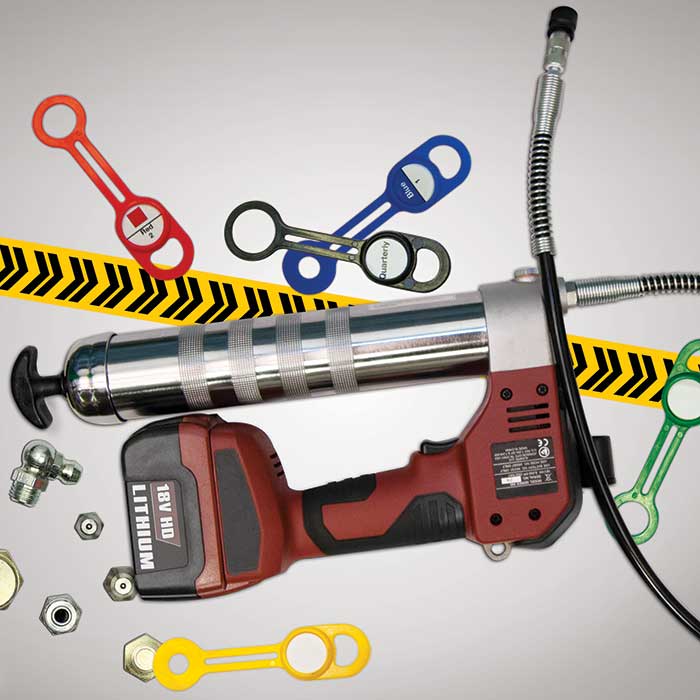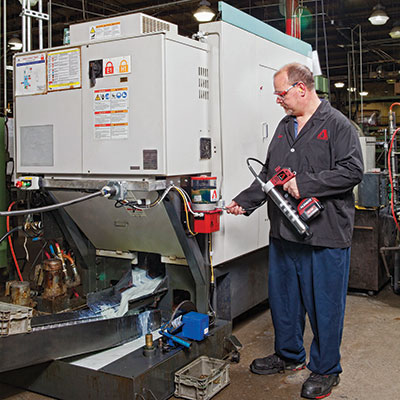How to Operate a Grease Gun Safely
All machinery must be lubricated to ensure smooth operation and to maximize equipment life. From manufacturing to farming to wind energy applications, grease guns are one of the most common ways to achieve proper lubrication. Although use of grease guns is widespread, these tools deserve respect and should be used in accordance with the manufacturer’s safety guidelines to avoid injury.
There are four main types of grease guns on the market: manual, battery-operated, air-powered and AC electric. Each type has its own specific set of guidelines, but many general rules are applicable to all, such as training, proper tool use and care, work area safety and personal safety.
Manual Grease Guns
Manual grease guns include lever-action and pistol-grip models. These popular tools are widely used and are the most economical type of grease gun. Manual grease guns can achieve pressures up to 10,000 pounds per square inch (psi), while plug-valve sealant guns can reach 15,000 psi.
Battery-operated Grease Guns
Battery-operated grease guns are ideal for speeding up routine lubrication tasks. Using this type of grease gun can also help to minimize operator fatigue. These grease guns are rated anywhere from 6,000 to 10,000 psi, depending on the model.

Air-powered Grease Guns
Air-powered or pneumatic grease guns use compressed air to apply pressure to an air piston, which drives the grease piston and forces lubricant out of the coupler into a grease fitting. By depressing the gun’s trigger, a steady flow of lubricant is dispensed. Typically, pneumatic grease guns are rated up to 6,000 psi.
AC Electric Grease Guns
AC electric or corded grease guns provide a consistent flow of grease and are often used as an alternative to air-powered tools. AC electric grease guns generally are rated up to 7,000 psi.
Training
Effective lubrication requires specific training, ranging from the actual physical activity of applying the lubricant to the effects of misapplication, including spills and damage to machinery. The operator should be trained on each piece of equipment to be lubricated, as well as each grease gun that will be used to accomplish the task.
“Some general rules of lubrication also should be considered,” said Alemite senior product manager Americo dos Santos. “Do not apply lubricants to a machine in operation unless the fittings are located in a safe place. Never reach over, under, through or past moving parts of the equipment to complete your task. You should maintain proper footing and balance at all times to facilitate better control of the tool in unexpected situations.”
Proper Tool Use and Care
Whether you are using a manual, battery-operated, air-powered or AC electric grease gun, the high pressure developed by the tool should be considered. High pressure can develop in different ways. A common situation when high pressure is created involves what is known as a “frozen fitting.” When a fitting is not lubricated for an extended period of time, the grease in the line may “cake.” Mineral or vegetable oil in the grease gets consumed and leaves a waxy, soap-like base. This soap thickener is what makes grease a semi-solid. Common soaps include calcium stearate, sodium stearate and lithium stearate, as well as mixtures of these components.
 High-pressure injection injuries may be caused by accidental injection of grease through the skin and into the underlying tissue. Generally, fingers or hands experience this type of injury, which is most likely to occur when a hose ruptures. Also, some lubrication applications require needle-type accessories that can lead to an injury if used improperly.
High-pressure injection injuries may be caused by accidental injection of grease through the skin and into the underlying tissue. Generally, fingers or hands experience this type of injury, which is most likely to occur when a hose ruptures. Also, some lubrication applications require needle-type accessories that can lead to an injury if used improperly.
“An injection injury may be very small and essentially painless, and the injured person may be tempted to continue working,” explained dos Santos. “However, if you receive any type of injection injury, you should seek medical attention immediately. The lubricant will need to be removed and treatment initiated to prevent infection. If possible, provide the medical technician with the brand of grease or oil involved so that the manufacturer can be contacted regarding the possible toxicity of the lubricant.”
Safety features are available and precautions can be taken to minimize the risk involved in using high-pressure grease guns. The key is to use the right tool for the job. Do not improvise or change the grease gun configuration for any purpose other than that which it was intended.
It is critical that all of the components utilized are rated for the amount of pressure being applied, so you should use only hoses specified by the grease gun manufacturer. For example, if your grease gun is rated at 10,000 psi and your hose is only rated at 1,500 psi, the situation can become hazardous very quickly.
“It also is essential that you inspect the hose between the grease gun and the coupler before each use,” dos Santos stressed. “If there are any signs of wear or damage on the hose, do not use it.”
When a grease cartridge is loaded into the grease gun, the follower rod should be securely latched to the end cap so it doesn’t spring back unexpectedly. Use care when removing the pull-tab on the cartridge to prevent getting cut by the tab’s sharp edges. In addition, always aim the grease coupler away from your body when loading and priming the grease gun. You don’t want to take any chances that grease may get into your eyes.
Battery-operated grease guns have a few safety guidelines of their own. For instance, the power switch should be in the off position before inserting the battery pack. The battery pack should always be disconnected from the grease gun before changing accessories or unscrewing the grease cylinder from the gun. Never attempt to open the battery pack or expose it to water.
When not in use, keep the battery pack away from metal objects such as paper clips, coins, keys, nails, screws or other small items that can make a connection from one terminal to another. Under abusive conditions, liquid may escape from the battery and should be avoided. If contact with this liquid occurs, flush with water. If the liquid contacts your eyes, seek medical attention.
When using a battery charger, use only the charger specified by the manufacturer. Ensure that the cord is situated so it will not be stepped on, tripped over or otherwise subjected to stress. Do not operate the charger with a damaged cord or plug, or if it has received a sharp blow or been dropped. You should also refrain from charging batteries or using any electrical (corded) grease gun in damp areas.
“Other workplace practices involve operating, caring for and servicing your grease gun,” dos Santos noted. “Always read and follow the manufacturer’s instructions before using your grease gun. Avoid kinking hoses, as this can weaken them and make them more susceptible to ruptures. Be sure to label your grease gun so that you can identify the type of grease in that particular gun. Also, you should wipe grease fittings and the grease coupler clean before connecting to prevent contamination.”
 Battery-operated, air-powered and AC electric grease guns can build extreme pressures, which may not be evident to the user. Therefore, extra caution should be taken with these tools. Never exceed the maximum input air pressure on pneumatic tools. Most of these grease guns run at a 40-to-1 grease pressure to air ratio, so substantial pressure is created with a relatively low input air pressure.
Battery-operated, air-powered and AC electric grease guns can build extreme pressures, which may not be evident to the user. Therefore, extra caution should be taken with these tools. Never exceed the maximum input air pressure on pneumatic tools. Most of these grease guns run at a 40-to-1 grease pressure to air ratio, so substantial pressure is created with a relatively low input air pressure.
Keep grease guns clean and avoid placing them on dirty surfaces. All repairs should be performed by a qualified technician who uses only original replacement parts. Finally, when lubrication tasks are performed, grease often gets on your hands, so be sure to wash them to remove any chemical residue.
Work Area Safety
Regardless of the type of grease gun you choose, it is important to keep your work area clean and well lit. Cluttered and dark areas invite accidents of many kinds. Oil or grease spills on floors, catwalks and ladders can cause serious falls and fire hazards. Wipe up lubricant spills immediately or use absorbent drying pads or granules. Sources of lubricant leaks should be repaired to maintain a safe environment.
“If you are using a power tool, make sure that the area is free of flammable liquids, gases or dust, which may be ignited if the tool creates a spark,” dos Santos added. “In addition, power tools should not be exposed to rain or wet conditions, and care should be taken to prevent cord damage, as this can increase the risk of electric shock.”
Minimize distractions, such as bystanders, while operating your grease gun, as they may divert your attention from the task at hand. Never play around with or use a grease gun for practical jokes.
Personal Safety
It is recommended that you wear personal protective equipment including safety glasses, gloves and non-skid shoes or boots to help prevent injury. Refrain from wearing jewelry or loose or torn clothing that could become caught in moving parts.
Stay alert while using a grease gun. You should never operate any tool if you are tired or impaired by alcohol or medication, as a moment of inattention may result in serious personal injury.
By utilizing sound procedures, training and appropriate tool use and care, you can maximize potential bottom-line benefits received from proper grease gun lubrication techniques while maintaining worker safety.
